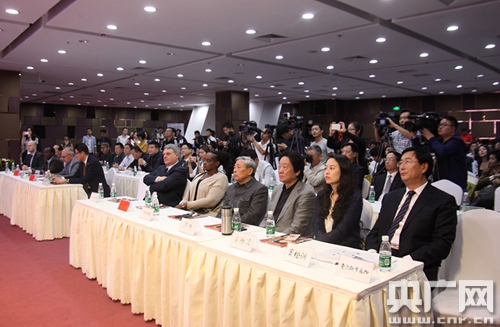World-class Check-in Place! This New Golden Line For Cultural And Tourism In Northwest China Will Allow The World To See The "temperature Of The Earth"
World-class Check-in Place! This New Golden Line For Cultural And Tourism In Northwest China Will Allow The World To See The "temperature Of The Earth"
The cultural and natural heritage of the Hexi Corridor complement each other, coexist and deeply integrate, forming the most typical heritage route in China.
Recently, the "Implementation Plan for the Construction of National Heritage Lines of the Hexi Corridor" jointly formulated by multiple departments in Gansu was released, marking that the Hexi Corridor has become a place for national heritage lines to be built.
It is reported that the key tasks of the plan are: focusing on the construction of the "five models", focusing on selecting 52 representative cultural and natural heritages including important grotto temples, the Great Wall, ancient city sites, ancient buildings, famous cities and towns and Zhangye Caiqiu, 20 national intangible cultural heritage projects, and deploying 19 specific tasks.
The plan clearly states that by the end of 2025, the overall layout of the Hexi Corridor national heritage line "one belt is connected, six cities are linked, and multi-point support" will be built; by the end of 2030, the "five models" of the protection, inheritance and utilization of cultural heritage lines of the Hexi Corridor national heritage line, the protection, inheritance and utilization of natural heritage, the protection, inheritance and display of ethnic and folk customs intangible cultural heritage, international tourism belt, and international cultural exchanges and cooperation will be fully built; by the end of 2035, we will strive to successfully apply for the core area of the Hexi Corridor national heritage line as a World Heritage Site.
According to He Xiaozu, director of the Gansu Provincial Department of Culture and Tourism, the construction of the Hexi Corridor National Heritage Line will promote the implementation of 120 specific tasks in 2025, with an estimated investment of 610 million yuan.
Hexi Corridor Visual China
Jin Zhun, Secretary-General of the Tourism Research Center of the Chinese Academy of Social Sciences, analyzed to Observer.com that the introduction of the plan marks an important step in Gansu's deepening the adjustment and innovation of the tourism industry structure. This plan has far-reaching significance for innovating tourism formats, enriching tourism supply, and activateing heritage resources along the Hexi Corridor. By integrating the unique cultural, historical heritage and natural resources of the Hexi Corridor into the framework of the national heritage route, the productization, connection and integrated development of resources has been promoted, the development dimension of the Hexi Corridor has been enriched, and tourists can reshape their understanding of this area.
What is the Hexi Corridor?
The Hexi Corridor is located in the main transportation route between the hinterland of Asia and the Central Plains. It starts from Wushaoling in the east and Xingxing Gorge in the west. It is about 1,000 kilometers long and covers six cities and 21 counties in Jiuquan, Jiayuguan, Zhangye, Jinchang, Wuwei and Baiyin Jingtai. Because it is located west of the Yellow River, it is called the Hexi Corridor.
As one of the areas on the Silk Road with the richest geographical units, the richest historical relics and the most distinctive natural landscape, the entire Hexi Corridor has 5 World Cultural Heritage Sites, 59 national key cultural relics protection units, 2,165 kilometers of Hanming Great Wall, 3 national historical and cultural cities, and 79 museums; 299 national and provincial intangible cultural heritages; 2 world geological parks, 1 national park, 8 national nature reserves, and 23 national nature parks.
The natural scenery of "solate smoke in the desert" and the unique landscape of sand and springs coexisting are full of poetry; the thousand-year-old Mogao Grottoes lying quietly in the desert and Gobi illuminates the thousand-year-old civilization fusion... The cultural and natural heritage of the Hexi Corridor complement each other, coexist and deeply integrate, forming the most typical heritage route in China.
This year marks the tenth anniversary of China's proposal of "Vision and Action to Promote the Joint Construction of the Silk Road Economic Belt and the 21st Century Maritime Silk Road". In February, the Ministry of Culture and Tourism issued the "Notice on Promoting the Deep Integration and Development of Intangible Cultural Heritage and Tourism", emphasizing that under the premise of effective protection, it is necessary to promote the integration of intangible cultural heritage and tourism on a wider range, deeper level and higher level, so that tourism can become an important carrier for promoting the excellent traditional Chinese culture, continuously forging a strong sense of community for the Chinese nation, promoting the all-round development of people, and serving the people's high-quality life.
"The natural scenery and cultural history of the areas along the Silk Road attract a steady stream of overseas tourists, becoming a core hub for the development of the inbound tourism market and an important link for cultural exchanges." Xu Peng, vice chairman of the World Tourism Alliance, said that the international influence of "Silk Road Tour" is constantly rising, becoming the first choice for many overseas tourists to enter China for in-depth tours.
According to the relevant plan of the Gansu Provincial Department of Culture and Tourism, in the next step, it will vigorously improve the tourism quality of world cultural heritage sites, world geological parks, national scenic spots, and national 5A-level tourist attractions through a series of measures such as the implementation of a series of measures such as the strengthening brand project, and promote the construction of Jiayuguan Pass City, Zhangye Qicai Danxia and other places into core scenic spots for world-class tourist destinations. Accelerate the quality upgrade of Jiayuguan cultural relics scenic spots and promote the Hexi Corridor to become a well-known tourist destination at home and abroad.
Jinjun suggested that tourism companies can take this opportunity to develop characteristic tourism products with cultural heritage as the core, combining local ethnic culture and intangible cultural heritage resources. Looking forward to the future, the key to inspiring the vitality and vitality of the Hexi Corridor National Heritage Line is to further explore and promote the cultural connotation of the region.
First of all, we should pay attention to the protection and innovative transformation of cultural resources, combine traditional culture with modern tourism needs, and launch tourism products with in-depth experience.
Secondly, it is also crucial to strengthen cross-regional and cross-industry cooperation. Through linkage with the regions along the route and related industries, we must form an organic integration of cultural tourism, ecological tourism and historical heritage to create a tourism circle with continuous attractiveness.
Finally, strengthening infrastructure construction and service improvement, especially the improvement of transportation networks and digital services, will greatly enhance tourists' experience and the sustainable development of the tourism industry.





